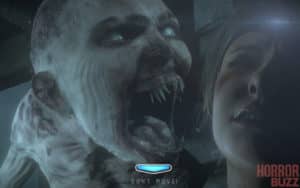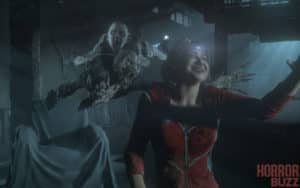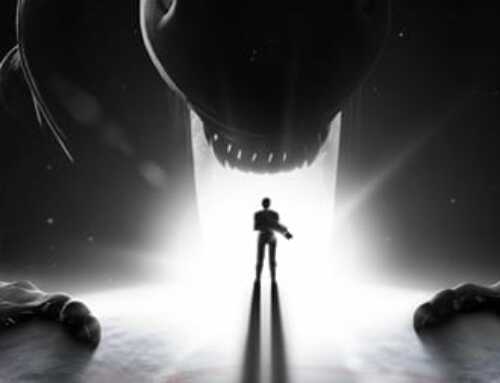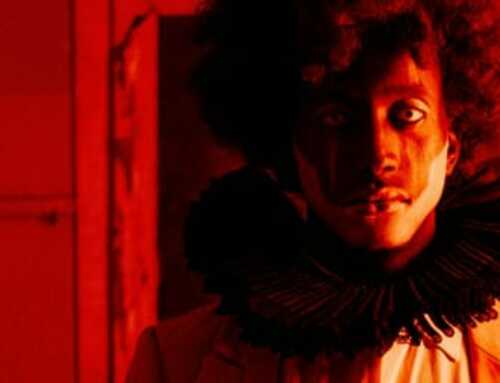We here at Horror Buzz really missed the boat on “Until Dawn” when it came out last year. We’re terribly sorry about that. However, we now have a chance to redeem ourselves for that. “Until Dawn” has recently become a $20 budget title. So here we go with a review of it for anyone who, like me, wasn’t sure that they wanted to spend $60 on a reportedly rather short video game.
 “Until Dawn” is a game that really pitched its story as its main selling point. The basic gist of the game’s plot is that a group of friends in their late teens are gathering at the same ski lodge where two of their friends mysteriously disappeared in a tragic accident a year previous. This plot my sound familiar to anyone out there who has ever seen a horror movie before. The game does not try to pretend that its basic set-up is anything novel. In fact it wears its influences on its sleeve, including clear homages to films like “Saw” and “The Thing.” However, rather than use these homages as a chance to give the player a sly wink to suggest that they are a joke that the writers were in on, “Until Dawn” decides to work these influences into being part of the natural flow of its own story. At one point in the game, one can find movie posters for films which took a similar approach to their own influences (ex. “House of the Devil” and “The Innkeepers”). So what’s so great about the game’s story then? Two things. First, barring a few fumbles in the opening, it’s actually incredibly well written. All of the characters have very distinct personalities and the writers do a great job of making them all feel like real people that you would want to survive this trial. Second, the player has a lot of control over how the story plays out. More on that later.
“Until Dawn” is a game that really pitched its story as its main selling point. The basic gist of the game’s plot is that a group of friends in their late teens are gathering at the same ski lodge where two of their friends mysteriously disappeared in a tragic accident a year previous. This plot my sound familiar to anyone out there who has ever seen a horror movie before. The game does not try to pretend that its basic set-up is anything novel. In fact it wears its influences on its sleeve, including clear homages to films like “Saw” and “The Thing.” However, rather than use these homages as a chance to give the player a sly wink to suggest that they are a joke that the writers were in on, “Until Dawn” decides to work these influences into being part of the natural flow of its own story. At one point in the game, one can find movie posters for films which took a similar approach to their own influences (ex. “House of the Devil” and “The Innkeepers”). So what’s so great about the game’s story then? Two things. First, barring a few fumbles in the opening, it’s actually incredibly well written. All of the characters have very distinct personalities and the writers do a great job of making them all feel like real people that you would want to survive this trial. Second, the player has a lot of control over how the story plays out. More on that later.
 “Until Dawn” looks absolutely stunning. In fact, I cannot think of any game that I’ve ever played which looked better than “Until Dawn” does. The characters all look incredibly life-like, which is no surprise given that they used a lot of motion-capture to get them down right. Most mo-cap games (and, honestly, games in general) kind of falter when it comes to faces and facial expressions. “Until Dawn” does not. Its faces all look amazing. The characters all have really distinct silhouettes too, which is great since it allows you to tell all eight of your playable characters apart with ease. The game also stars a few fairly well-known actors, ex. Hayden Panettiere (TV’s “Heroes”) and Peter Stormare (“The Lost World: Jurassic Park”), and they are all easily recognizable without looking awkwardly shoe-horned in.
“Until Dawn” looks absolutely stunning. In fact, I cannot think of any game that I’ve ever played which looked better than “Until Dawn” does. The characters all look incredibly life-like, which is no surprise given that they used a lot of motion-capture to get them down right. Most mo-cap games (and, honestly, games in general) kind of falter when it comes to faces and facial expressions. “Until Dawn” does not. Its faces all look amazing. The characters all have really distinct silhouettes too, which is great since it allows you to tell all eight of your playable characters apart with ease. The game also stars a few fairly well-known actors, ex. Hayden Panettiere (TV’s “Heroes”) and Peter Stormare (“The Lost World: Jurassic Park”), and they are all easily recognizable without looking awkwardly shoe-horned in.
The game has some great audio, as well. The score does a really great job of setting the game’s atmosphere. It’s got the right sort of sparse bleakness to convey the isolated ski lodge setting but still has enough bombast to make the really tense, dramatic moments pop out like they should. The sound effects are subtle enough to actually be realistic, which is rare in a video game. “Until Dawn” also uses the PlayStation 4’s controller speaker very well, using it to underscore particularly tense moments by making the sound that much closer to the player. The voice-acting is perhaps the best I’ve ever heard in a game as well. The game’s actors aren’t content to simply phone it in because it’s just a video game. Instead we hear actual, great performances. More importantly than even that, the dialogue works well. The characters actually sound like they’re having conversations instead of sounding like each actor recorded all of their lines separately without having any context.
 The quickest way to describe the gameplay of “Until Dawn” is that it plays like how David Cage always tries to get his games to play. For those of you who aren’t sure who David Cage is please allow me to explain. “Until Dawn” is an intensely cinematic experience. It’s not game interspersed with cutscenes that advance the plot. Instead, essentially every moment of the gameplay is spent advancing the story, and even the cutscenes are frequently interactive. So, for instance, sometimes a character may be running from someone stalking them and instead of relying on the player to know where to go, the game will control the character’s movement while still allowing the player the ability to control whether to grab objects to topple behind themselves or upon reaching a fork in the road the game would let the player choose which way to go. It is those choices that are one of the main selling points of “Until Dawn.” The game features a butterfly effect system in which choices made at one point in the game will have effects that ripple outward and change later events. Now, this won’t change the overall arc of the story, but it can alter how many scenes play out, how the characters think of each other (and thus altering the way that they interact with each other), and even who lives or dies. Each of the eight characters in the game has at least one point where the decisions that the player makes decide whether that character lives or dies. Some characters have a lot more opportunities to die than others. While this system may not allow for total control of the story, it allows for far more changes than I had originally expected. The amount of control over the story that the game gives to the player truly astounds me (especially when one takes into account how much extra work must have gone into voicing the differing scenes).
The quickest way to describe the gameplay of “Until Dawn” is that it plays like how David Cage always tries to get his games to play. For those of you who aren’t sure who David Cage is please allow me to explain. “Until Dawn” is an intensely cinematic experience. It’s not game interspersed with cutscenes that advance the plot. Instead, essentially every moment of the gameplay is spent advancing the story, and even the cutscenes are frequently interactive. So, for instance, sometimes a character may be running from someone stalking them and instead of relying on the player to know where to go, the game will control the character’s movement while still allowing the player the ability to control whether to grab objects to topple behind themselves or upon reaching a fork in the road the game would let the player choose which way to go. It is those choices that are one of the main selling points of “Until Dawn.” The game features a butterfly effect system in which choices made at one point in the game will have effects that ripple outward and change later events. Now, this won’t change the overall arc of the story, but it can alter how many scenes play out, how the characters think of each other (and thus altering the way that they interact with each other), and even who lives or dies. Each of the eight characters in the game has at least one point where the decisions that the player makes decide whether that character lives or dies. Some characters have a lot more opportunities to die than others. While this system may not allow for total control of the story, it allows for far more changes than I had originally expected. The amount of control over the story that the game gives to the player truly astounds me (especially when one takes into account how much extra work must have gone into voicing the differing scenes).
I was cautiously optimistic about “Until Dawn.” However, it quickly became apparent that there was no need for the caution. There is absolutely nothing else on the market like “Until Dawn.” It succeeds at things that other games have been trying and failing at for years. And moreover, it does that with a grace and confidence that makes it seem easy. I got my twenty dollars with within the first two hours of my first playthrough. I really cannot recommend “Until Dawn” highly enough.







